 W
WA cluster munition is a form of air-dropped or ground-launched explosive weapon that releases or ejects smaller submunitions. Commonly, this is a cluster bomb that ejects explosive bomblets that are designed to kill personnel and destroy vehicles. Other cluster munitions are designed to destroy runways or electric power transmission lines, disperse chemical or biological weapons, or to scatter land mines. Some submunition-based weapons can disperse non-munitions, such as leaflets.
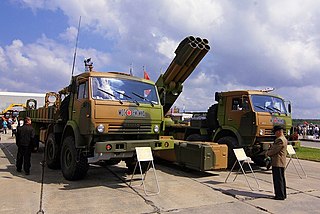 W
WThe 9A52-4 Tornado is Russia's newest universal multiple rocket launcher. It was designed as a lightweight and universal version of the BM-30 Smerch, dubbed 9A52-2. It was first unveiled in 2007 as a more strategically and tactically mobile launcher, albeit at the expense of a slight reduction in firepower. This model is aimed at replacing the previous generation of Russian multiple rocket launchers, including BM-21 Grad, BM-27 Uragan and BM-30 Smerch. Currently the sole operator is Russian Ground Forces. A version will be approved for export.
 W
WThe MBDA Apache, or Apache AP, is a French-developed air-launched anti-runway cruise missile, manufactured by European arms company MBDA. The Apache system is at the base of the SCALP EG concept, notably for the aerodynamics and the stealth feature. The SCALP EG also has a different propulsion system as well as a different warhead. While the SCALP uses a single high-penetration warhead, the Apache's effect is obtained by dispersal of 10 cluster submunitions.
 W
WThe Cluster Munitions Ban Advocates are a group of individuals whose lives have been affected by cluster munitions, a particular type of explosive weapon that has been banned for its indiscriminate area effects and risk from unexploded ordnance. They come from Afghanistan, Albania, Cambodia, Croatia, Ethiopia, Iraq, Laos, Lebanon, Tajikistan, Serbia and Vietnam. The Ban Advocates took an active role in the Oslo Process on cluster munitions that led to the Convention on Cluster Munitions, a treaty banning cluster munitions and providing innovative provisions to assist the victims of these weapons. The Ban Advocates initiative was launched in October 2007 by Handicap International Belgium, a founding member of the Nobel Peace Prize-winning International Campaign to Ban Landmines. The Ban Advocates spoke in front of the international community on many occasions. According to the Irish Minister for Justice, "The indomitable spirit of the Ban Advocates, overcoming terrible injuries to bear witness to the horrors of cluster munitions, inspired us throughout." The Ban Advocates blog provides regular updates on their work around the world.
 W
WBL755 is a cluster bomb developed by Hunting Aircraft that contains 147 parachute-retarded high explosive anti-tank (HEAT) submunitions. Its primary targets are armoured vehicles and tanks with secondary soft target capabilities. It entered service with the Royal Air Force (RAF) in 1973.
 W
WThe BM-21 "Grad" is a Soviet truck-mounted 122 mm multiple rocket launcher. The weapons system and the M-21OF rocket were first developed in the early 1960s, and saw their first combat use in March 1969 during the Sino-Soviet border conflict. BM stands for boyevaya mashina, and the nickname grad means "hail". The complete system with the BM-21 launch vehicle and the M-21OF rocket is designated as the M-21 field-rocket system. The complete system is more commonly known as a Grad multiple rocket launcher system. In NATO countries the system was initially known as M1964. Several other countries have copied the Grad or have developed similar systems.
 W
WThe BM-27 Uragan is a self-propelled multiple rocket launcher system designed in the Soviet Union. It began its service with the Soviet Army in the late 1970s, and was its first modern spin and fin stabilized heavy multiple rocket launcher.
 W
WThe BM-30 Smerch, 9K58 Smerch or 9A52-2 Smerch-M is a Soviet heavy multiple rocket launcher. The system is intended to defeat personnel, armored, and soft targets in concentration areas, artillery batteries, command posts and ammunition depots. It was designed in the early 1980s and entered service in the Soviet Army in 1989. When first observed by the West in 1983, it received the code MRL 280mm M1983. It continued in use by Russia; a program to replace it by the 9A52-4 Tornado was launched in 2018.
 W
WThe CBU-24 is an unguided, aircraft delivered anti-personnel and anti-materiel weapon developed by the United States. Because it is an unguided weapon, the CBU-24 can be carried and dropped by any aircraft capable of carrying standard "dumb" or "iron" bombs.
 W
WThe CBU-100 Cluster Bomb is an American cluster bomb which is employed primarily in an anti-tank mode. It weighs 222 kg and carries 247 Mk 118 Mod 1 bomblets.
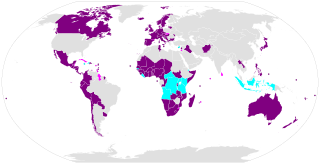 W
WThe Convention on Cluster Munitions (CCM) is an international treaty that prohibits all use, transfer, production, and stockpiling of cluster bombs, a type of explosive weapon which scatters submunitions ("bomblets") over an area. Additionally, the Convention establishes a framework to support victim assistance, clearance of contaminated sites, risk reduction education, and stockpile destruction. The convention was adopted on 30 May 2008 in Dublin, and was opened for signature on 3 December 2008 in Oslo. It entered into force on 1 August 2010, six months after it was ratified by 30 states. As of July 2021, a total of 123 States have joined the Convention – 110 States Parties and 13 Signatories.
 W
WA Dual-Purpose Improved Conventional Munition (DPICM) is an artillery or surface-to-surface missile warhead designed to burst into sub-munitions at an optimum altitude and distance from the desired target for dense area coverage. The sub-munitions use both explosively formed penetrators for anti-armor work and fragmentation for antipersonnel work. Some sub-munitions may be designed for delayed reaction or mobility denial (mines). The air-to-surface variety of this kind of munition is better known as a cluster bomb. They are banned by some countries under the Convention on Cluster Munitions.
 W
WThe LAR-160 is a light artillery rocket with a 160mm calibre, a minimum range of 12 km and a maximum range of 45 km, from a multiple rocket launcher. Each standard launcher holds two 13 rocket Launch Pod Containers (LPC's) for truck or trailer mounting, 18 rocket LPC's for medium armored vehicle's and 26 rocket LPC's for mounting on a MBT chassis. A light version is also manufactured which can be carried by helicopters and towed behind vehicles such as a HMMWV.
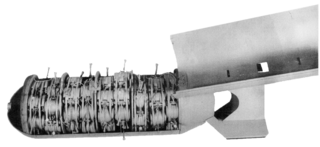 W
WThe M29 cluster bomb was a 500-pound (230 kg) cluster bomb used by the United States Air Force during World War II against troops, unarmoured vehicles and artillery. The weapon contained ninety 4-pound (1.8 kg) M83 fragmentation submunitions - a direct copy of the earlier German Butterfly Bomb - in 9 ten-bomb "wafers". The M28 was a 100-pound (45 kg) equivalent of the M29 containing 24 bomblets.
 W
WThe M33 cluster bomb, also known as the (M33) Brucella cluster bomb, was a U.S. biological cluster bomb developed in the early 1950s and deployed in 1952. It was the first standardized biological weapon in the U.S. arsenal.
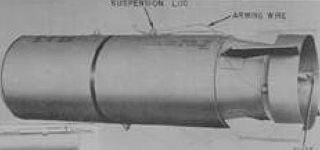 W
WThe M34 cluster bomb was the first mass-produced United States Army weapon meant to deliver the chemical agent sarin (GB). A large stockpile of M34s was destroyed between 1973 and 1976.
 W
WThe M43 BZ cluster bomb, or simply M43 cluster bomb, was a U.S. chemical cluster bomb intended to deliver the incapacitating agent known as BZ. The weapon was produced in the early 1960s and all stocks of U.S. BZ were destroyed by 1989.
 W
WThe M44 generator cluster was an American chemical cluster bomb designed to deliver the incapacitating agent BZ. It was first mass-produced in 1962 and all stocks of the weapons were destroyed by 1989.
 W
WThe M69 incendiary bomblet was used in air raids on Japan and China during World War II, including the firebombing of Tokyo in 1945. It was created by the Standard Oil Development Company, whose work was funded by the Office of Scientific Research and Development. They were nicknamed "Tokyo calling cards". The M69 was a plain steel pipe with a hexagonal cross section 3 inches (7.6 cm) in diameter and 20 inches (51 cm) long. It weighed about 6 pounds (2.7 kg).
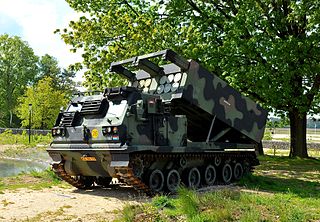 W
WThe M270 Multiple Launch Rocket System is an armored, self-propelled, multiple rocket launcher.
 W
WThe MGM-140 Army Tactical Missile System (ATACMS) is a surface-to-surface missile (SSM) manufactured by the U.S. defense company Lockheed Martin. It has a range of over 100 miles (160 km), with solid propellant, and is 13 feet (4.0 m) high and 24 inches (610 mm) in diameter.
 W
WThe MGR-1 Honest John rocket was the first nuclear-capable surface-to-surface rocket in the United States arsenal. Originally designated Artillery Rocket XM31, the first unit was tested on 29 June 1951, with the first production rounds delivered in January 1953. Its designation was changed to M31 in September 1953. The first Army units received their rockets by year's end and Honest John battalions were deployed in Europe in early 1954. Alternatively, the rocket was capable of carrying an ordinary high-explosive warhead weighing 1,500 pounds (680 kg).
 W
WThe RRAB-3, nicknamed the Molotov bread basket, was a Soviet-made droppable bomb dispenser that combined a large high-explosive charge with a cluster of incendiary bombs. It was used against the cities of Finland during the Winter War of 1939–1940. The bomb consisted of a cylinder 2.25 metres (7.4 ft) long and 0.9 metres (3.0 ft) in diameter.
 W
WThe MW-1 is a German munitions dispenser similar to the British JP233. It is designed to be carried on the Tornado IDS, although it can be carried on the F-104 Starfighter and the F-4 Phantom. The MW-1 started to be phased out after the German Government ratified the Convention on Cluster Munitions in 2009.
 W
WThe OTR-23 Oka was a mobile theatre ballistic missile deployed by the Soviet Union near the end of the Cold War to replace the obsolete SS-1C 'Scud B'. It carried the GRAU index 9K714 and was assigned the NATO reporting name SS-23 Spider. The introduction of the Oka significantly strengthened Soviet theatre nuclear capabilities as its range and accuracy allowed it not only to strike hardened NATO targets such as airfields, nuclear delivery systems, and command centers, but moving targets as well. It also had a fast reaction time, being able to fire in approximately five minutes, and was nearly impossible to intercept, thereby allowing it to penetrate defenses.
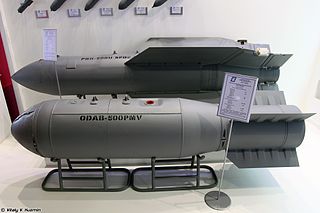 W
WThe PBK-500U Drel is an inertial and GLONASS-guided cluster glide bomb developed by the Russian Federation, designed to destroy enemy armored vehicles and buildings. Drel is equipped with friend or foe identification system and electronic countermeasures making it resistant to jamming and radar detection and is planned to be introduced to the Russian military in 2018. Bazalt considers equipping Drel with a pulsejet engine to increase its range.
 W
WUnexploded ordnance, unexploded bombs (UXBs), and explosive remnants of war (ERW) are explosive weapons that did not explode when they were employed and still pose a risk of detonation, sometimes many decades after they were used or discarded. UXO does not always originate from wars; areas such as military training grounds can also hold significant numbers, even after the area has been abandoned. UXO from World War I continue to be a hazard, with poisonous gas filled munitions still a problem. When unwanted munitions are found, they are sometimes destroyed in controlled explosions, but accidental detonation of even very old explosives also occurs, sometimes with fatal results.